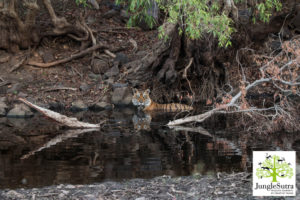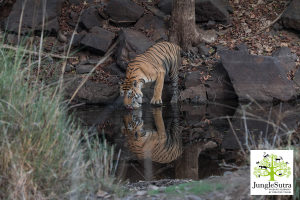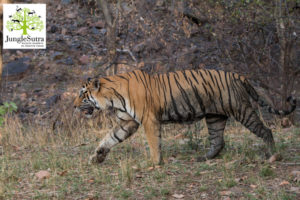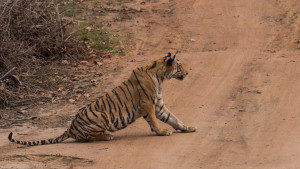The Legendary Tigers of Corbett
January 5, 2019 - 4 minutes read What makes a tiger legendary? The wildlife guides at Jungle Sutra list several factors that contribute to tigers becoming living legends in the national parks and reserves where they lead wildlife safaris.
What makes a tiger legendary? The wildlife guides at Jungle Sutra list several factors that contribute to tigers becoming living legends in the national parks and reserves where they lead wildlife safaris.
In the competitive jungle environment, big cats compete for territory, prey base and mating rights. But they also face other challenges such as poaching, habitat loss and man-animal conflict, road and train accidents.
Survival is not easy. Most tigers can’t hold their territories for more than 3-5 years. Those that survive for that long or more are a step closer to be regarded as legends.
Next comes individual characteristics such as size — length and weight (important when it comes to male tigers), boldness,  strength or even aggression and hunting. For some tigers, characteristics like shyness (from humans/vehicles) help them hold on to their territories and survive longer than others. For female tigers, the number of litters that they have raised to adulthood is important to factor in.
strength or even aggression and hunting. For some tigers, characteristics like shyness (from humans/vehicles) help them hold on to their territories and survive longer than others. For female tigers, the number of litters that they have raised to adulthood is important to factor in.
Lastly and most importantly, every legend needs a special name. The tigers of Ranthambhore National Park are probably India’s best-known big cats today owing to how they were identified and written about. Although naming wild tigers might seem like a pointless thing to some people, a unique name adds a lot of value, as it gives the individual an identity that humans can relate to and by extension try to protect.
The tigers of Corbett National Park haven’t been documented as well as those in Rajasthan or central India. But then there were Dheetoo & Khali.
 Dheetoo
Dheetoo
The big cat’s name that was derived from his stubbornness, a trait he shares with the robot R2 D2 of Star Wars fame. Dheetoo was such a majestic animal that wildlife authorities decided to lure him down from the hills to grasslands where people visiting the park would have a chance to see and appreciate him.
A water buffalo with a bell around its neck was used as bait and gradually moved through the terrain in which they wanted Dheetoo to expand his territory. The tiger became so used to this baiting that often just ringing a bell was enough to get him out of his hiding. But eventually the bell ringers got too close and the tiger was declared a man-eater and moved to a zoo in Kanpur.
When you visit Corbett, be sure to ask your guide or driver about this legendary tiger — they’ll probably tell you that, to this day, there hasn’t been a cat in the region that could match Dheetoo in size, grace, boldness and strength. Definitely a legend.
Khali
Believe it or not, this tiger was named after the Great Khali — a World Wresting Entertainment (WWE) heavyweight  champion who stood 7 feet, 3 inches tall and weighed 400 pounds.
champion who stood 7 feet, 3 inches tall and weighed 400 pounds.
With an estimated weight of 250 kg (550 lbs), he’s considered to be one of the largest tigers that ever roamed the park. At the age of ten, Khali was a force to be reckoned with and injured many tigers that dared to enter his territory.
Not much is known about Khali’s lineage although the Corbett region is known for big tigers like the Bachelor of Powalgarh, which measured 10 feet, 7 inches over curves. Another Corbett cat — shot in 1967 — holds the Guinness Record for the world’s largest-ever tiger, measuring 11 feet, 1 inch over the curves and weighing 389 kg (860 lbs).
0 Comments